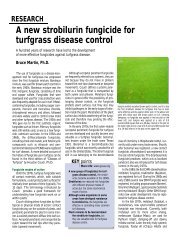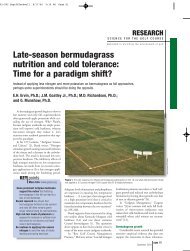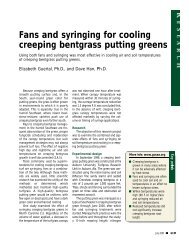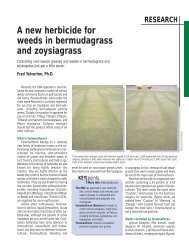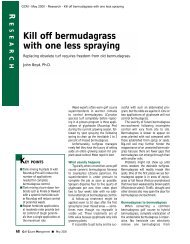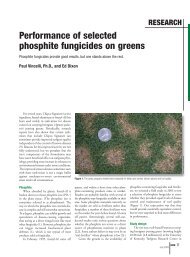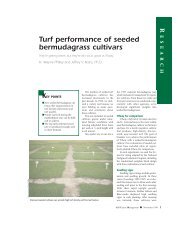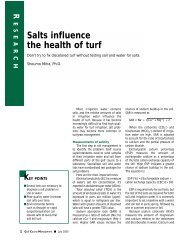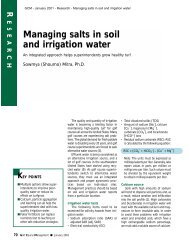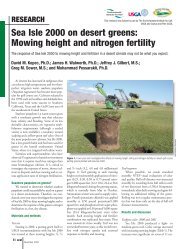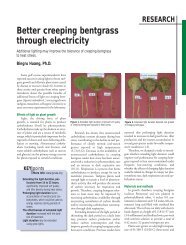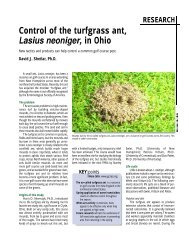Seeded bermudagrass response to herbicides during ... - GCSAA
Seeded bermudagrass response to herbicides during ... - GCSAA
Seeded bermudagrass response to herbicides during ... - GCSAA
Create successful ePaper yourself
Turn your PDF publications into a flip-book with our unique Google optimized e-Paper software.
Although injury <strong>to</strong> <strong>bermudagrass</strong> fromthese <strong>herbicides</strong> is physiologically interestingbecause these <strong>herbicides</strong> are primarily activeon dicotyledonous broadleaf plants, suchinjury has been reported previously for established<strong>bermudagrass</strong> turf. Repeat applicationsof Confront have been reported <strong>to</strong> causeinjury levels of 30%-40% <strong>to</strong> common, Tifwayhybrid and Tifeagle hybrid <strong>bermudagrass</strong>es(6). Bermudagrass injury from products containingtriclopyr is so significant that triclopyris often used in spray mixes with fenoxapropor fluazifop for selective removal of <strong>bermudagrass</strong>from tall fescue (Festuca arundinacea) andRESEARCHzoysiagrass (Zoysia species) (3).Similar trends were observed for theeffect of <strong>herbicides</strong> for broadleaf weed controlon common <strong>bermudagrass</strong> cultivar groundcover (Table 2). The low and high rates ofConfront reduced ground cover compared <strong>to</strong>the nontreated plots for all cultivars 21 days% GROUND COVER VS. HERBICIDESPrincess 77 Riviera Savannah YukonDays after intial treatment21 42 21 42 21 42 21 42Rate Application timingHerbicide (metric units) (DAIT)% cultivar ground cover*AAtrex 2.0 quarts/acre 0 24 d 79 c 29 d 88 abc 26 d 75 b 4 f 25 e(4.7 liters/hectare)Millennium Ultra (low) 1.25 pints/acre 0 68 ab 84 b 80 a 92 abc 82 a 97 a 29 d 59 cd(1.5 liters/hectare)Millennium Ultra (high) 2.5 pints/acre 0 68 ab 85 b 65 bc 87 bc 81 a 95 ab 29 d 61 bcd(2.9 liters/hectare)Trimec Classic (low) 1.75 pints/acre 0 76 ab 89 ab 68 bc 85 c 83 a 97 a 41 c 62 bcd(2.0 liters/hectare)Trimec Classic (high) 3.5 pints/acre 0 63 bc 91 ab 71 bc 89 abc 80 a 97 a 31 d 64 bc(4.1 liters/hectare)Revolver 17.4 fl oz/acre 0 82 ab 94 ab 84 a 97 ab 84 a 95 ab 48 ab 76 a(1.3 liters/hectare)MSMA (low) 1.35 fb 1.35 pints/acre 0 fb 7 71 ab 99 a 82 c 99 a 82 c 97 a 53 a 81 a(1.6 fb 1.6 liters/hectare)MSMA (mid) 2.0 fb 2.0 pints/acre 0 fb 7 80 ab 99 a 82 a 98 ab 82 a 97 a 39 c 81 a(2.3 fb 2.3 liters/hectare)MSMA (high) 2.65 fb 2.65 pints/acre 0 fb 7 78 ab 99 a 79 ab 99 a 80 a 93 ab 43 b 80 a(3.1 fb 3.1 liters/hectare)Drive 1.0 lb/acre(1.1 kilograms/hectare) 0 79 ab 100 a 72 b 99 a 84 a 97 a 25 d 71 ab+ 1.5 pints/acre(1.8 liters/hectare) of MSOConfront (low) 1.0 pints/acre 0 51 c 89 ab 69 bc 94 abc 66 b 92 ab 16 e 55 c(1.2 liters/hectare)Confront (high) 2.0 pints/acre 0 43 c 91 ab 66 bc 88 abc 41 c 86 ab 11 ef 51 d(2.3 liters/hectare)Monument 0.47 ounces/acre 0 75 ab 97 ab 62 c 95 abc 83 a 93 ab 29 d 63 b(32.9 grams/hectare)+ 0.25% v/v NISNot treated — — 81 ab 91 ab 82 a 97 ab 83 a 97 a 55 a 71 ab*Different letters within the same column indicate significant differences in % ground cover among treatments for the same cultivar.Note. Treatments applied from four <strong>to</strong> seven weeks after emergence at the onset of uniform s<strong>to</strong>lon development. Percent <strong>bermudagrass</strong> ground cover rated on ascale of 0 <strong>to</strong> 100, where 0 equals bare ground and 100 equals no exposed soil. Abbreviations: DAIT, days after initial treatment; fb, followed by; MSO, methylated seedoil surfactant; NIS, non-ionic surfactant.Table 2. Percent green turf coverage by the seeded bermuagrass cultivars 21 and 42 days after initial treatment (DAIT) applied four <strong>to</strong> seven weeks after seedlingemergence when cultivars begin s<strong>to</strong>lon development.January 2005GCM 157
RESEARCHafter initial treatment. However, by 42 daysafter initial treatment, all cultivars exceptYukon recovered <strong>to</strong> a level similar <strong>to</strong> that ofthe nontreated plots. This further illustratesthat Yukon is generally more susceptible <strong>to</strong><strong>herbicides</strong> <strong>during</strong> seedling establishment.The low and high rates of Trimec Classicand Millennium Ultra reduced Yukon groundcover compared <strong>to</strong> the nontreated plots 21days after initial treatment. However, by 42days after initial treatment, ground cover forYukon was similar <strong>to</strong> that for nontreated turf.A similar trend was observed for Rivieratreated with high rates of Trimec Classic andMillennium Ultra and for Princess 77 treatedwith low and high rates of Trimec Classic.Response <strong>to</strong> Revolver and MonumentRevolver did not injure (Table 1) orreduce ground cover (Table 2) of any cultivarevaluated at any rating date. The only adverseeffect of Monument was a reduction inRiviera and Yukon ground cover at 21 daysafter initial treatment; at 42 days after initialtreatment, both cultivars had ground coversimilar <strong>to</strong> that of nontreated turf.Repeat applications of Revolver andMonument have been previously reported <strong>to</strong>cause little <strong>to</strong> no injury <strong>to</strong> established <strong>bermudagrass</strong>turf (2,8). No direct comparison can bemade <strong>to</strong> seedling <strong>bermudagrass</strong> <strong>to</strong>lerance <strong>to</strong>these <strong>herbicides</strong>. However, the sulfonylureaherbicide, Manor (metsulfuron), has beenreported <strong>to</strong> cause greater injury <strong>to</strong> Jackpot,Mirage and Numex Sahara than 2,4-D,dicamba, Lontrel (clopyralid) and Drive (7).Further research is needed <strong>to</strong> evaluate potential<strong>to</strong>lerance differences <strong>to</strong> sulfonylurea <strong>herbicides</strong>among common <strong>bermudagrass</strong> cultivars.THE RESEARCH says . . .Repsonse <strong>to</strong> MSMA and DriveIn general, the effects of the MSMA andDrive treatments in terms of turfgrass injury orground cover reduction were similar <strong>to</strong> the nontreatedcontrol. However, at 14 days after initialtreatment, injury <strong>to</strong> Yukon from Drive and thehigh rate of MSMA was greater than the injuryin the nontreated plots (Table 1). Slight injuryfrom Drive <strong>to</strong> seedling common <strong>bermudagrass</strong>cultivars and subsequent recovery by 30 days afterinitial treatment has been reported previously (7).These authors also reported that five common<strong>bermudagrass</strong> cultivars (Jackpot, Mirage, NuMexSahara, Princess 77 and Yukon) did not differ intheir <strong>response</strong> <strong>to</strong> MSMA or Drive.At 21 days after initial treatment, Driveand mid and high rates of MSMA reducedYukon ground cover compared <strong>to</strong> the nontreatedplots. By 42 days after initial treatment,Yukon had recovered from thesetreatments. At 21 days after initial treatment,Drive reduced Riviera ground cover compared<strong>to</strong> the nontreated plots. Riviera recoveredfrom these treatments by 42 days after initialtreatment. MSMA and Drive did not reduceground cover of Princess 77 or Savannah compared<strong>to</strong> the nontreated plots at 21 or 42 daysafter treatment. Sequential applications ofMSMA at 2.7 pints/acre (2.2 kilograms activeingredient/hectare) can injure fully established<strong>bermudagrass</strong> turf, but injury usually does notexceed 30%, and the <strong>bermudagrass</strong> fullyrecovers in two <strong>to</strong> four weeks.ConclusionsThe application safety of <strong>herbicides</strong> variedamong the four <strong>bermudagrass</strong> cultivars, withYukon being generally more susceptible <strong>to</strong>injury than the other cultivars. AAtrex shouldnot be applied <strong>to</strong> any of the cultivars we evaluatedat or before uniform s<strong>to</strong>lon development,approximately four <strong>to</strong> seven weeks afterseeding. Various herbicide pre-mixtures containing2,4-D, mecoprop, dicamba, clopyralidor triclopyr should be used with caution whenapplied at or before s<strong>to</strong>lon development.Revolver, MSMA, Monument and Drive aregenerally safe for the four cultivars evaluated.Although we observed some injury at 14 daysafter initial treatment and reduced groundcover at 21 days after initial treatment withthese <strong>herbicides</strong>, all cultivars recovered by 42days after initial treatment.Literature cited1. Bunnell, B.T., R.D. Baker, L.B. McCarty, D.W. Hall andD.L. Colvin. 2002. Differential <strong>response</strong> of five bahiagrass(Paspalum notatum) cultivars <strong>to</strong> metsulfuron.Weed Technology 17:550-553.2. Busey, P. 2004. Goosegrass (Eleusine indica) controlwith foramsulfuron in <strong>bermudagrass</strong> (Cynodonspp.) turf. Weed Technology 18:634-640.3. Cudney, D.W., C.L. Elmore, V.A. Gibeault and J.S.Reints. 1997. Common <strong>bermudagrass</strong> (Cynodondactylon) management in cool-season grasses.Weed Technology 11:478-483.4. Hassan, G., G. Mueller-Warrant and S. Griffith. 2002.Differential sensitivity of Italian ryegrass (Loliummultiflorum) cultivars <strong>to</strong> fenoxaprop. Weed Science50:567-575.5. Johnson, B.J. 1995. Tolerance of four seeded common<strong>bermudagrass</strong> (Cynodon dactylon) types <strong>to</strong> <strong>herbicides</strong>.Weed Technology 9:794-800.6. Johnson, B.J., and R.R. Duncan. 2001. Effects of herbicidetreatments on suppression of seashore paspalum(Paspalum vaginatum) in <strong>bermudagrass</strong>(Cynodon spp.). Weed Technology 15:163-169.7. McCalla, Jr., J.H., M.D. Richardson, D.E. Karcher andJ.W. Boyd. 2004. Tolerance of seedling <strong>bermudagrass</strong><strong>to</strong> postemergence <strong>herbicides</strong>. Crop Science44:1330-1336.8. McElroy, J.S., F.H. Yelver<strong>to</strong>n and L.S. Warren, Jr.2004. Control of green and false-green kyllinga(Kyllinga brevifolia and K. gracillima) at golf coursefairway and rough mowing heights. WeedTechnology (In review).9. National Turfgrass Evaluation Program. 2004.http://www.ntep.org (confirmed Oct. 15, 2004).➤ Yukon is generally more sensitive <strong>to</strong> <strong>herbicides</strong> than Princess 77, Riviera andSavannah.➤ AAtrex and Confront should not be applied <strong>during</strong> establishment of any seeded<strong>bermudagrass</strong> cultivar. Injury from Confront is primarily attributed <strong>to</strong> triclopyr.➤ Herbicides generally used for broadleaf weed control such as 2,4-D, dicamba,mecoprop, clopyralid and triclopyr should be used with caution <strong>during</strong> seeded <strong>bermudagrass</strong>establishment.➤ Drive, Monument and MSMA are generally safe for all cultivars, but some delay ingrow-in may occur.➤ When applied after initial s<strong>to</strong>lon development, Revolver did not injure or delay grow-inof any cultivar <strong>during</strong> seeded establishment.J. Scott McElroy, Ph.D. (mcelroy@utk.edu), is an assistantprofessor and Greg K. Breeden, M.S., is an extensionassistant in the plant science department, University ofTennessee, Knoxville. Fred H. Yelver<strong>to</strong>n, Ph.D., is a professorand Travis W. Gannon, M.S., is a research associatein the crop sciences department, North Carolina StateUniversity, Raleigh. Shawn D. Askew, Ph.D., is an assistantprofessor in the department of plant pathology, physiologyand weed science, Virginia Polytechnic and StateUniversity, Blacksburg. Jeffery F. Derr, Ph.D., is a professorin the department of plant pathology, physiology andweed science, Virginia Polytechnic and State University,Hamp<strong>to</strong>n Roads Agricultural Research and ExtensionCenter, Virginia Beach.158 GCMJanuary 2005



